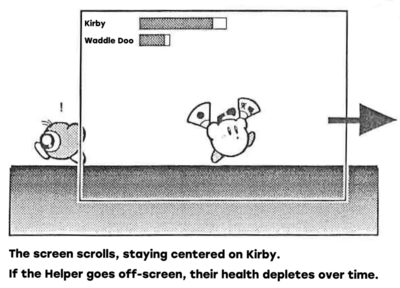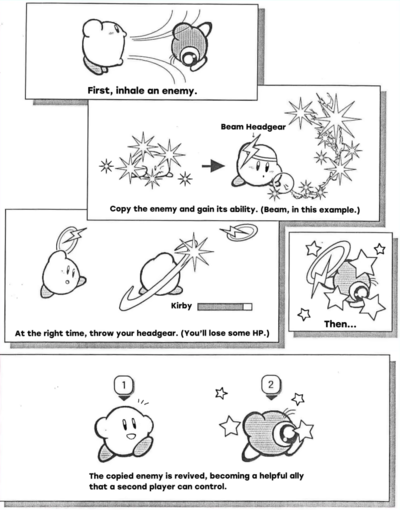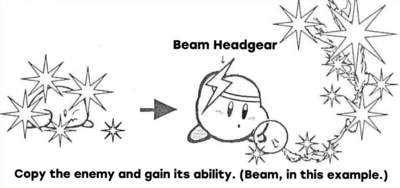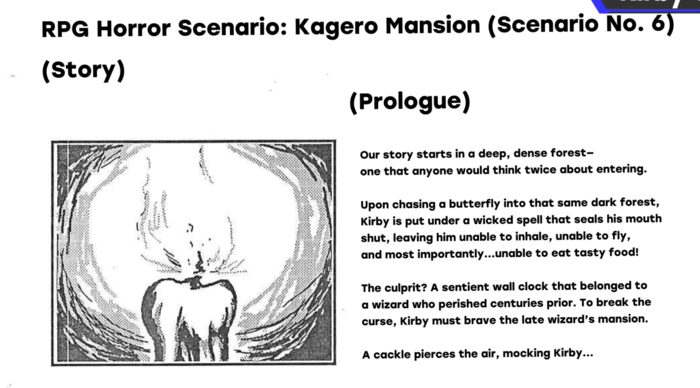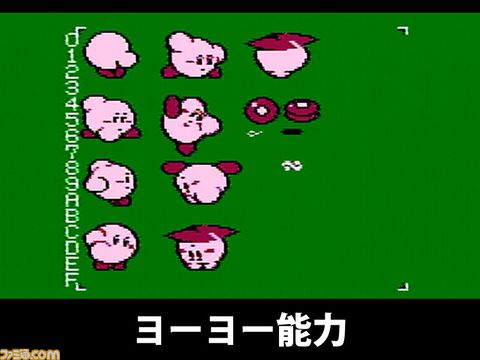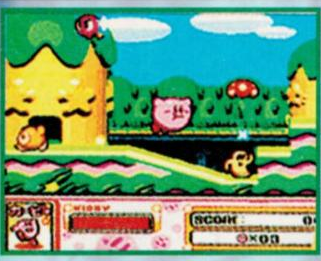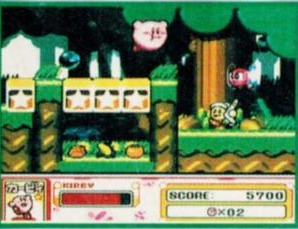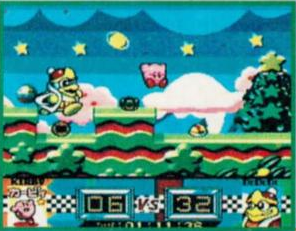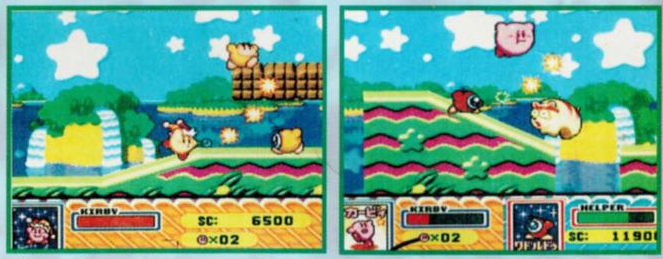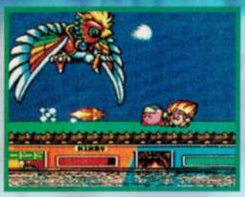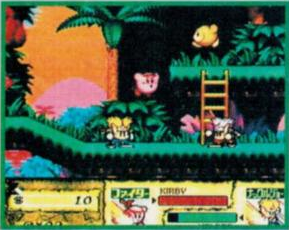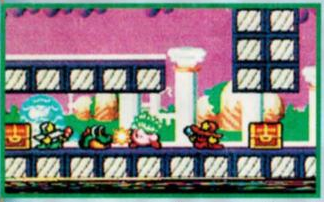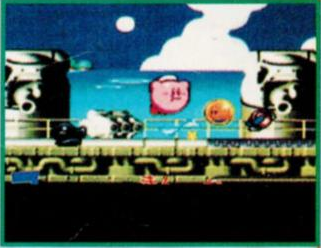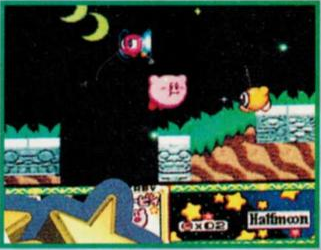Prerelease:Kirby Super Star
This page details prerelease information and/or media for Kirby Super Star.
Contents
Early Development
After Kirby's Adventure was finished, there was downtime while the Super Famicom development environment was set up, and so work on the game wasn't top priority. Sakurai was given a Macintosh to, at least partially, work on development of the game, alongside his Twin Famicom setup.
The concept for the game started during a conversation with Miyamoto, where Miyamoto asked if a two-player Kirby game would be possible, a feature Miyamoto had been wanting to add to the Mario series for a while but the fast-paced gameplay didn't allow for it. He suggested this two-player feature for Kirby because Kirby moves slower than Mario. Sakurai noted, though, that it might have actually been a tougher ask to make a two-player Kirby game than a two-player Mario game due to the varied speeds of the Copy Abilities that had already been introduced in Kirby's Adventure.
Title
The original title of the game was "Kirby of the Stars: Active", suggesting that the game had more active gameplay. Shigesato Itoi (creator of EarthBound) was eventually brought in to help with the naming process, resulting in the name "Kirby of the Stars: Super Deluxe", which suggests a luxurious, "deluxe" experience. Itoi's idea also resulted in the game's packaging being designed to resemble Paulownia wood, which is normally used to store high-quality silverware and sake, again supporting its deluxe quality.
Helper System
Pieces of concept art showcasing an early version of the helper system.
- In the top concept art piece, Kirby can be seen carrying two traditional Japanese fans, which don't get used in the final game. Interestingly, it appears that this concept artwork of Kirby holding Japanese fans would later be redrawn as an unused "goal" icon.
- Overall, the artwork pieces show some of the health mechanics working differently. Kirby is shown sacrificing some of his health to make a helper, the helper's health is significantly lower (where instead they are equal in the final game), and the health of the helper would also deplete if they stayed offscreen.
- Also shown is Kirby throwing his Copy Ability to spawn a helper. In the final game, you spawn helpers from above your head with your ability, and you would throw your ability to change your helper.
- The Beam Ability is depicted with a different hat (or headgear as the art labels it)- Instead of being a dual-coloured jester's hat, it's a ring with a lightning bolt on its side.
- In the "Kirby Super Star" video, Sakurai says that he originally wanted some kind of item to create helpers.
Copy Abilities
Beam Ability
An early design for the Beam hat which can be seen in concept art. Instead of being designed after a jester hat, it's a headband with a lightning bolt symbol attached, potentially as a placeholder. Interestingly, it bears a resemblance to the Mii Copy ability hat Kirby can wear in the Super Smash Bros. games.
Rush, Card, Wing, Flower, and Mantle Ability
Concept art for several scrapped abilities was featured in the booklet packaged with the Japanese version of Kirby's Dream Collection:
- The Fighter ability was originally known as "Rush".
- Card - This ability lets Kirby throw cards. Kirby wears a top hat. This ability would later appear in Kirby & the Amazing Mirror as "Magic", and Kirby would be able to throw cards with this ability in Kirby Squeak Squad.
- An early design for the Wing ability, it lacks the feathered headdress and instead opts for a more angelic design that bears more of a resemblance to Cupid Kirby from Kirby and the Amazing Mirror.
- Flower - This scrapped ability would have planted flowers on enemy's heads, poisoning them. Kirby wears a large ribbon. This ability is a reference to the game Panel de Pon and its protagonist Lip.
- Mantle - A scrapped ability showing a move similar to how a matador taunts a bull. Kirby doesn't wear a hat with this ability.
Game Modes
Spring Breeze
Originally, Spring Breeze was planned to not include Copy abilities at all (presumably due to the fact it's an abridged remake of Kirby's Dream Land, which didn't have Copy abilities), but Sakurai reluctantly put it in at the request of one of Nintendo's producers. In subsequent years, Sakurai has mentioned that he wishes players could play Spring Breeze without Copy abilities, at least on a first playthrough.
Kagero Mansion
In the original proposal for Kirby Super Star, a seventh main game mode was conceptualized. It was a game mode with RPG and horror elements, called "Kagero Mansion".
The description on the original design document gives a summary of the story, and demonstrates how the mode would work:
RPG Horror Scenario: Kagero Mansion (Scenario No. 6) (Story) (Prologue) Our story starts in a deep, dense forest- one that anyone would think twice about entering. Upon chasing a butterfly into that same dark forest, Kirby is put under a wicked spell that seals his mouth shut, leaving him unable to inhale, unable to fly, and most importantly...unable to eat tasty food! The culprit? A sentient wall clock that belonged to a wizard who perished centuries prior. To break the curse, Kirby must brave the late wizard's mansion. A cackle pierces the air, mocking Kirby...
Sakurai describes Kagero Mansion further: Kirby would set out on a survival adventure using items based on various Copy abilities. For example, inside the mansion Kirby would get the Fire ability from a candle - an extinguished candle can be seen in the concept art above. The mode would also include puzzle elements.
It was ultimately cut for schedule and ROM space reasons; they weren't able to even start making it, meaning it probably didn't make it past the concept phase.
Area Backgrounds
Originally, the backgrounds of Kirby Super Star were hand-drawn. Midway through development, the art was thrown out and it was decided a CG style influenced by Donkey Kong Country should be used instead.
This was one of the various reasons development dragged on. While Sakurai was certain that there would be some merits to using CG, he doesn't think that it turned out especially well in hindsight - the staff wasn't familiar with the format, resulting in some difficulty stitching the art assets together, and Sakurai believes it wasn't well-suited for Kirby in general.
Famicom Prototype
To do:
|
Kirby Super Star started development on Sakurai's personal Twin Famicom setup, the same one used to develop Kirby's Dream Land, due to the lack of a Super Famicom development kit. It was only shown internally at HAL and was meant for testing ideas.
Some images of the prototype's sprites along with a video demonstrating the Cutter ability animating on Famicom hardware were posted on a Famitsu article featuring Masahiro Sakurai in 2017, where he states that the team used his Famicom development tools while waiting for the Super Famicom tools to be prepared.
Early Screenshots
The March 3, 1996 issue of the Mexican Club Nintendo magazine showed off a preview for Kirby Super Star, referred to as "Kirby's Adventure Super The Luxe", likely a mistranslation. The page can be read here.
From Spring Breeze, Green Greens with a slightly different layout of enemies.
Also from Spring Breeze, the infamous self-bombing Poppy Bros. in the second room of Green Greens was originally a Boomerang Poppy Bros. It's even sporting the green palette!
Course 1 of Gourmet Race with much more sky visible - it's cut off and much lower in the final game. King Dedede also has a different portrait.
Peanut Plains in Dyna Blade has a completely different level layouts than the final game's. The assets remained the same, though.
The fight against Dyna Blade uses a blue sky, where the final game uses a sky that swaps between cyan and purple, with the sky turning purple when Dyna Blade swoops in. It's unclear if Dyna Blade is in the middle of her defeat animation and the sky is turning blue again, but the shade of blue is noticeably darker then the final's cyan.
Also, Burning Leo is using his red and grey enemy palette, rather than his blue and green helper one.
From The Great Cave Offensive, a slightly different version of Sub-Tree Area's first room. The only notable changes are the thin slope in the bottom-left corner, a solid slope in the final, and the slightly different enemy choices.
Also from The Great Cave Offensive, Garden Area with a pink sky, or ceiling, since it's underground, rather than a blue one, plus a rather different level layout.
From Revenge of Meta Knight, a Halberd portion set during the daytime. This same palette can be still found in the areas with this tileset of Great Cave Offensive.
From Milky Way Wishes, a couple differences in this screenshot of Halfmoon. Enemies haven't been palette-swapped yet, plus the enemies featured here are different than the final game's. The Waddle Doo was replaced with a sleeping Grizzo in the final. The background also sports a double moon, something not shown in the final game.
